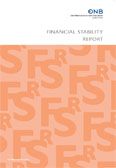Financial Stability Report 22
 OeNB
OeNB
- published:
- December 2011.
 OeNB
OeNB
Financial Stability Report 22 (PDF, 3.6 MB) December 2011.
Developments in the Sovereign Dept Crisis Will Be Crucial for Financial Stability (PDF, 1.6 MB) en Dec 15, 2011, 12:00:00 AM
Deteriorating Outlook for the World Economy (PDF, 3.1 MB) en Dec 15, 2011, 12:00:00 AM
Real Economy’s Risk Position Remains Below Precrisis Level (PDF, 2.3 MB) en Dec 15, 2011, 12:00:00 AM
Austrian Financial System Faces a Persistently Difficult Environment (PDF, 2.4 MB) en Dec 15, 2011, 12:00:00 AM
Detecting Financial Stability Vulnerabilities in Due Time: Can Simple Indicators Identify a Complex Issue? (PDF, 2.1 MB) Neudorfer, Sigmund, Trachta. Neudorfer, Sigmund, Trachta – Financial Stability Report 22 This paper analyzes the resilience of credit institutions to instances of financial instability based on simple publicly available balance sheet and income statement figures. In the course of the recent financial crisis and the related credit turmoil, the loss absorption capacity of the global financial system has been stretched to its limit. Globally active financial institutions, many of them systemically relevant, needed government support to keep their capital ratios above regulatory and/or market required minima. Central banks had to step in to provide liquidity when large parts of the financial markets ceased to function. From an ex-post perspective, the crisis provided a real stress scenario which we use to explain bank performance by examining simple indicators such as capitalization, liquidity, funding structure and asset-side exposure. To cover systemically important European banks we choose a subset from the bank sample used by the European Banking Association for the EU-wide stress-testing exercise in 2011. We add three Austrian banks to arrive at a sample of 90 European banks in total (including altogether six Austrian banks). To measure bank performance, we use return on average assets, return on average equity, operating profits, required government support and equity prices. We show that these performance measures can be explained adequately by our simple indicators. We are able to identify the strong, respectively weak, banks that did not, respectively did, need government support in 2009. Regarding the other performance measures we give a forecast for 2011 about which banks are expected to perform well, ordinarily and poorly. en bank performance, financial crisis, stress testing, early warning E44, E32, E37 Dec 15, 2011, 12:00:00 AM
What Drives Aggregate Credit Risk? (PDF, 2.6 MB) Kerbl, Sigmund. Kerbl, Sigmund – Financial Stability Report 22 A deep understanding of the drivers of credit risk is valuable for financial institutions as well as for regulators from multiple viewpoints. The systemic component of credit risk drives losses across portfolios and thus poses a threat to financial stability. Traditional approaches consider macroeconomic variables as drivers of aggregate credit risk (ACR). However, recent literature suggests the existence of a latent risk factor influencing ACR, which is regularly interpreted as the latent credit cycle. We explicitly model this latent factor by adding an unobserved component to our models, which already include macroeconomic variables. In this paper we make use of insolvency rates of Austrian corporate industry sectors to model realized probabilities of default. The contribution of this paper to the literature on ACR risk is threefold. First, in order to cope with the lack of theory behind ACR drivers, we implement state-of-the-art variable selection algorithms to draw from a rich set of macroeconomic variables. Second, we add an unobserved risk factor to a state space model, which we estimate via a Kalman filter in an expectation maximization algorithm. Third, we analyze whether the consideration of an unobserved component indeed improves the fit of the estimated models. en credit risk, unobserved component models, state space, Kalman filter, stress testing E44, E32, E37 Dec 15, 2011, 12:00:00 AM
The Austrian Insurance Industry in CESEE: Risks and Opportunities from a Financial Stability Point of View (PDF, 1.9 MB) Bianchi, Ebner, Korherr, Ubl. Bianchi, Ebner, Korherr, Ubl – Financial Stability Report 22 This study gives an overview of the insurance market in Central, Eastern and Southeastern Europe (CESEE) in general and of the Austrian insurance groups’ activities in the region in particular. Moreover, it deals with risk management issues and the challenges arising from the new EU regulatory framework, Solvency II. We identify the main risks and opportunites for insurance groups in this respect: While potential market growth rates and still higher margins represent the main opportunities, there is also evidence of some reputational as well as financial risks. Further, cross-border business activities also pose some challenges for the risk management of internationally active insurance groups. From a macroprudential perspective, the Austrian insurance groups’ exposure to CESEE augments the exposure of Austria financial institutions to this region. en Central, Eastern and Southeastern Europe, Insurance, Austria G22, F15 Dec 15, 2011, 12:00:00 AM
Bank Supervision and Resolution: National and International Challenges (PDF, 2 MB) Summer. Summer – Financial Stability Report 22 en Dec 15, 2011, 12:00:00 AM
Annex of Tables (PDF, 1.8 MB) en Dec 15, 2011, 12:00:00 AM
Notes (PDF, 1.6 MB) en Dec 15, 2011, 12:00:00 AM